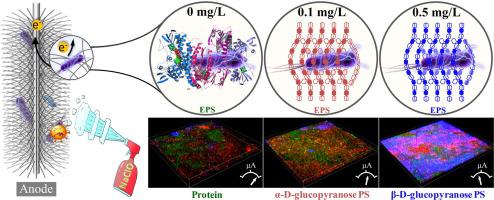Bioelectrochemistry ( IF 4.8 ) Pub Date : 2021-07-27 , DOI: 10.1016/j.bioelechem.2021.107894 Yue Dong 1 , Mingrui Sui 2 , Xin Wang 3 , Peng Zhang 4 , Yiying Jiang 1 , Jianyu Wu 1

|
Extensive amounts of chlorine disinfectants have been applied to wastewater system since the outbreak of coronavirus disease 2019 (COVID-19), which inevitably affects the pollutant degradation via interfering with electron transfer mediated by electroactive bacteria. Herein, the response of electroactive biofilm (EAB) to chronic chlorine exposure was investigated. Results showed the EAB formed without exposure (EAB-0) exhibited a 53% and 123% higher current output than that formed with 0.1 mg L−1 (EAB-0.1) and 0.5 mg L−1 (EAB-0.5) chlorine, respectively. The chronic chlorine exposure of EAB boosted the contents of extracellular polymeric substances (EPS) in EAB-0.1 and EAB-0.5 by over secretion of extracellular polysaccharides. The EAB-0.1 and EAB-0.5 also presented lower electron exchange capacities (EECs) of EPS, coincided with reduced relative abundance of Geobacter from 61% in EAB-0 to 52% in EAB-0.5. This study provided new insights into the application of engineered EAB for wastewater treatment in a disinfection environment.
中文翻译:

电活性生物膜对慢性氯暴露的反应:细胞外聚合物的组成和空间结构的见解
自2019年冠状病毒病(COVID-19)爆发以来,废水系统中已大量使用含氯消毒剂,这不可避免地会通过干扰电活性细菌介导的电子传递来影响污染物的降解。在此,研究了电活性生物膜(EAB)对慢性氯暴露的反应。结果显示,未暴露形成的 EAB (EAB-0) 的电流输出分别比使用 0.1 mg L -1 (EAB-0.1) 和 0.5 mg L -1 (EAB-0.5) 氯形成的 EAB 高 53% 和 123% 。 EAB的长期氯暴露通过细胞外多糖的过度分泌而增加了EAB-0.1和EAB-0.5中细胞外聚合物(EPS)的含量。 EAB-0.1 和 EAB-0.5 还表现出较低的 EPS 电子交换能力 (EEC),同时地杆菌相对丰度从 EAB-0 中的 61% 降低到 EAB-0.5 中的 52%。这项研究为工程化 EAB 在消毒环境中废水处理中的应用提供了新的见解。











































 京公网安备 11010802027423号
京公网安备 11010802027423号